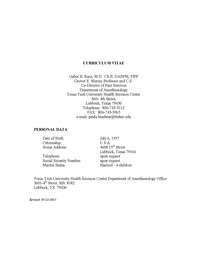Curriculum vitae

A curriculum vitae (English: /kəˈrɪkjʊləm ˈviːtaɪ, -ˈwiːtaɪ, -ˈvaɪtiː/)[1][2] (often shortened CV or vita) is a written overview of a person's experience and other qualifications for a job opportunity. It is akin to a résumé in North America. In some countries, a CV is typically the first item that a potential employer encounters regarding the job seeker and is typically used to screen applicants, often followed by an interview. CVs may also be requested for applicants to postsecondary programs, scholarships, grants and bursaries. In the 2010s, some applicants provide an electronic text of their CV to employers using email, an online employment website or using a job-oriented social networking service' website, such as LinkedIn.
Contents
In the United Kingdom, most Commonwealth countries, and Ireland, a CV is short (usually a maximum of two sides of A4 paper), and therefore contains only a summary of the job seeker's employment history, qualifications, education, and some personal information. Some parts of Asia require applicants' photos, date of birth, and most recent salary information. CVs are often tailored to change the emphasis of the information according to the particular position for which the job seeker is applying. A CV can also be extended to include an extra page for the jobseeker's publications if these are important for the job.
In the United States, Canada, Australia, Germany, and India, a CV is a comprehensive document used in academic circles and medical careers that elaborate on education, publications, and other achievements. A CV contains greater detail than a résumé, a shorter summary which is more often used in applications for jobs, but it is often expected that professionals use a short CV that highlights the current focus of their academic lives and not necessarily their full history. A CV is generally used when applying for a position in academia, while a resume is generally used when applying for a position in industry, non-profit, and the public sector.[3]
Etymology, spellings and pronunciation
Curriculum vitae is a Latin expression which can be loosely translated as [the] course of [my] life. In current usage, curriculum is less marked as a foreign loanword. Traditionally the word vitae is rendered in English using the ligature æ, hence vitæ,[4] although this convention is less common in contemporary practice.
The plural of curriculum vitae, in Latin, is formed following Latin rules of grammar as curricula vitae, and is used along with curricula vitarum,[5] both of which are debated as being more grammatically correct than the other.
In English, the plural of the full expression curriculum vitae is seldom used; the plural of curriculum on its own is usually written as "curricula",[6] rather than the traditional curriculums.[7]
See also
- Applicant tracking system
- Background check
- Human resources
- Cover letter
- Europass – European Standardised model
- hResume – a microformat for marking up résumés on web pages
- Résumé fraud
- Video résumé
References
- ↑ "Curriculum Vitae | Definition of Curriculum Vitae by Merriam-Webster". merriam-webster.com. Retrieved 27 June 2016.
- ↑ "American Heritage Dictionary Entry: curriculum vitae". ahdictionary.com. Retrieved 27 June 2016.
- ↑ "Resume vs. Curriculum Vitae: What's the Difference? | Internship and Career Center". icc.ucdavis.edu. Retrieved 27 June 2016.
- ↑ List of words that may be spelled with a ligature
- ↑ "alt.usage.english FAQ". Archived from the original on 3 April 2012. Retrieved 2 June 2012.
- ↑ American Heritage Dictionary of the English Language, Fourth Edition, Houghton Mifflin, 2009
- ↑ OED, 2nd edition, Oxford University Press, 1989
External links
| Look up curriculum vitae in Wiktionary, the free dictionary. |
| Wikimedia Commons has media related to Curriculum Vitae. |
- CV guide – Massachusetts Institute of Technology – Global Education & Career Development, United States
- Cover Letter guide – Massachusetts Institute of Technology – Global Education & Career Development, United States
- 10 tips on writing a successful CV – The Guardian